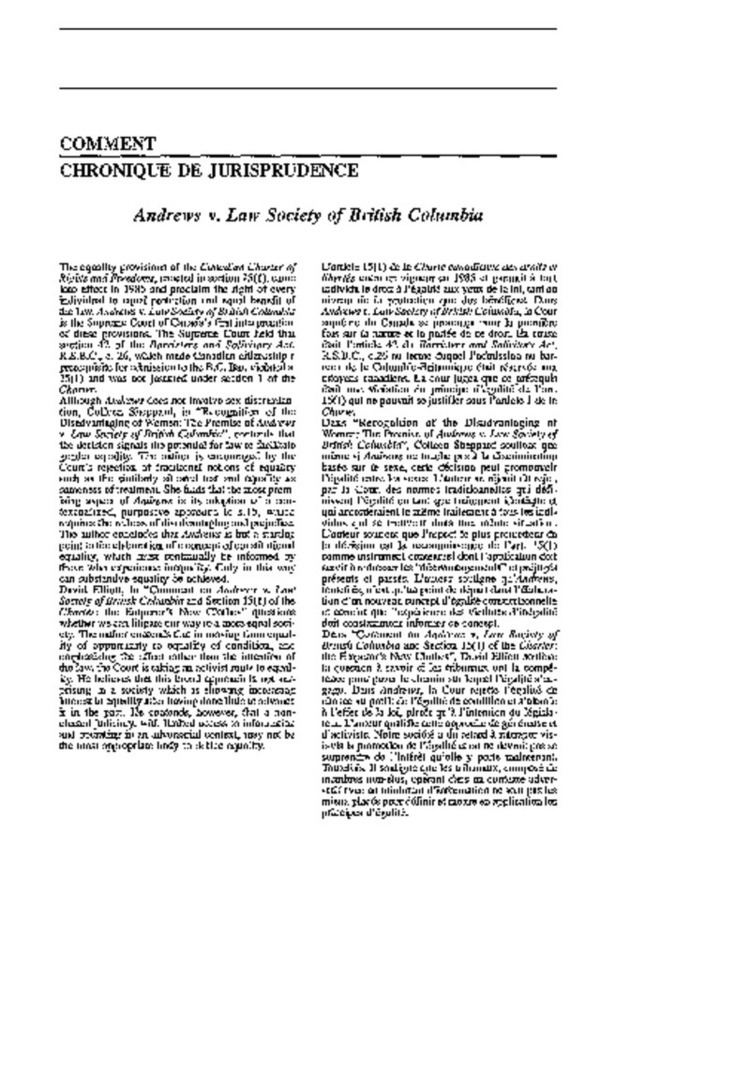Citations [1989] 1 S.C.R. 143 Ruling Appeal dismissed | Docket No. 19956 Docket number 19,956 | |
 | ||
Full case name The Law Society of British Columbia and The Attorney General of British Columbia v. Mark David Andrews and Gorel Elizabeth Kinersly Prior history Judgment for Andrews and Kinersly in the Court of Appeal for British Columbia. Majority Wilson J., joined by Dickson C.J. and L'Heureux-Dubé JJ. Similar R v Oakes, British Columbia (Public S, R v Big M Drug Mart Ltd | ||
Andrews v Law Society of British Columbia, [1989] 1 SCR 143 is the first Supreme Court of Canada case to deal with section 15 (equality rights) of the Canadian Charter of Rights and Freedoms. In the case the court outlined a test, sometimes called the Andrews test to determine if there has been a prima facie violation of equality rights. This case expanded the application of s.15 of the Charter by adding analogous grounds for discrimination to the extent enumerated grounds.
Contents
History
Andrews, a British subject and a permanent resident in Canada, met all the requirements for admission to the provincial bar with the exception that he was not a Canadian citizen. Andrews brought a motion to strike down the requirement for citizenship on the grounds it violated s. 15 of the Charter.
At the Trial level, Supreme Court of British Columbia held in favour of the Law Society. On appeal to the British Columbia Court of Appeal the ruling was overturned.
Judgment
The issue put to the court was whether the requirement of Canadian citizenship for admission to the British Columbia bar is an infringement upon or denial of the equality rights guaranteed by s. 15(1) of the Charter. And if so, whether it is justified under s. 1.
The court held that section 42 of Barristers and Solicitors Act violated s. 15 and it could not be saved under s. 1. The majority was written by Wilson J. with Dickson C.J. and L'Heureux-Dubé J. concurring.
In dissent McIntyre J. and Lamer J. disagreed on the point of the s. 1 analysis, believing that it would be upheld on the basis of "reasonable limit". The opinion on the "test", however, was unanimous.
Important Figures
List of important figures in the appeal:
Irwin Nathanson, Q.C., and Rhys Davies, for the appellant Law Society of British Columbia.
Joseph Arvay, for the appellant Attorney General of British Columbia.
Elizabeth C. Goldberg and David Dinklecock, for the intervener the Attorney General for Ontario.
Jean-Yves Bernard and Julie Hudon, for the intervener the Attorney General of Quebec.
Alison Scott, for the intervener the Attorney General of Nova Scotia.
Robert G. Richards, for the intervener the Attorney General for Saskatchewan.
Richard F. Taylor, for the intervener the Attorney General for Alberta.
P. B. C. Pepper, Q.C., for the intervener the Federation of Law Societies of Canada.
D. G. Cowper and W. S. Martin, for the respondents.
Mary Eberts and Gwen Brodsky, for the intervener the Women's Legal Education and Action Fund.
J. David Baker, for the intervener the Coalition of Provincial Organizations of the Handicapped.
Steven Barrett, for the interveners the Canadian Association of University Teachers and the Ontario Confederation of University Faculty Associations.
Reasoning
The court first defined a general approach to the equality guarantee. The court stated that the section is not a general guarantee of equality, rather it is only concerned with equal application of the law. It was further stated that it should be recognized that not all differences in treatment will result in inequality and that identical treatment may result in inequality.
As such, the suggestion to apply the same legal rules to groups or individuals who are "similarly situated" ("similarly situated test" where likes are treated alike and dislikes differently) was firmly rejected. The case of Bliss v. Canada, a pre-Charter SCC case where a pregnant woman was denied employment benefits, was considered as an example of the problems with such an approach.
Instead the court concentrated on the prohibition on discrimination.
. . . discrimination may be described as a distinction, whether intentional or not but based on grounds relating to the personal characteristics of the individual or group which has the effect of imposing burdens, obligations, or disadvantages on such individual or group not imposed on others, or which withholds or limits access to opportunities, benefits, and advantages available to other members of society. Distinctions based on personal characteristics attributed to an individual solely on the basis of association with a group will rarely escape the charge of discrimination, while those based on an individual’s merits and capacities will rarely be so classified. (p. 280)The court states the discrimination must be based on an "enumerated or analogous grounds", and the individual seeking to strike down a law must demonstrate the existence of differential treatment based on either of the two grounds. From there the onus shifts to the Crown who must show the law justified under s. 1.
